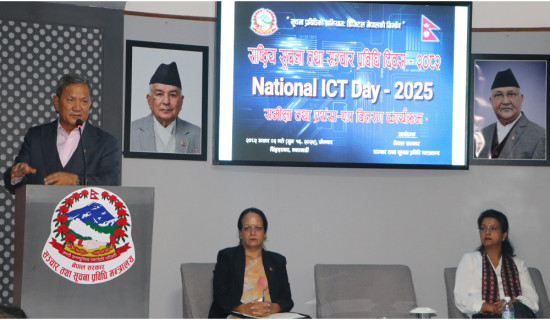- Monday, 16 June 2025
Minister Shahi pledges to implement master plan in interest of Chure community
Kathmandu, June 16: Minister for Forest and Environment, Ain Bahadur Shahi, has reaffirmed the government’s commitment to the effective implementation of the Chure-Terai-Madhesh Conservation and Management Master Plan, aimed at securing the livelihoods of communities dependent on the Chure region.
Speaking at a programme organized today to mark the 11th Chure Conservation Day in Kawasoti, Nawalparasi, Minister Shahi called upon all stakeholders to actively contribute to the conservation of the Chure.
The Chure region, extending from Ilam in the east to Kanchanpur in the west, spans 37 districts and covers 12.78 percent of Nepal’s total land area. It is geographically fragile and highly sensitive, characterized by loose soil, rich biodiversity, and serves as a habitat for rare wildlife as well as an important biological corridor.
On the occasion, the Minister stressed the Chure mountain range forms an inseparable connection among the hills, Dun, Bhawar, and the Terai-Madhesh plains. He further highlighted the region’s vital role as a water recharge zone for the Terai-Madhesh.
“The Chure region is home to over fifty percent of Nepal’s population, and its natural resources are fundamental to the livelihoods of communities within the area and the broader Terai-Madhesh region,” he stated.
Acknowledging the increasing pressure from human encroachment alongside natural challenges, the government launched the President Chure Conservation Programme in the fiscal year 2066/67 BS. Subsequently, on Asar 2, 2071 BS (June 16, 2014) , the President Chure-Terai-Madhesh Conservation Development Board was established to ensure more effective implementation of conservation efforts.
During his address, Minister Shahi stressed the need for broad public participation in Chure conservation, underscoring that “conservation of the Chure is a multi-stakeholder agenda.”
He added that the government is actively coordinating the formulation of additional policies and legal frameworks necessary for Chure conservation. Highlighting the importance of collaboration, he called for coordinated efforts among the federal, province, and local governments, local communities, and all relevant stakeholders to achieve conservation goals.
As part of today’s programme, the government also launched the planting of 10,000 saplings of various species to support restoration efforts, beginning today. (RSS)














